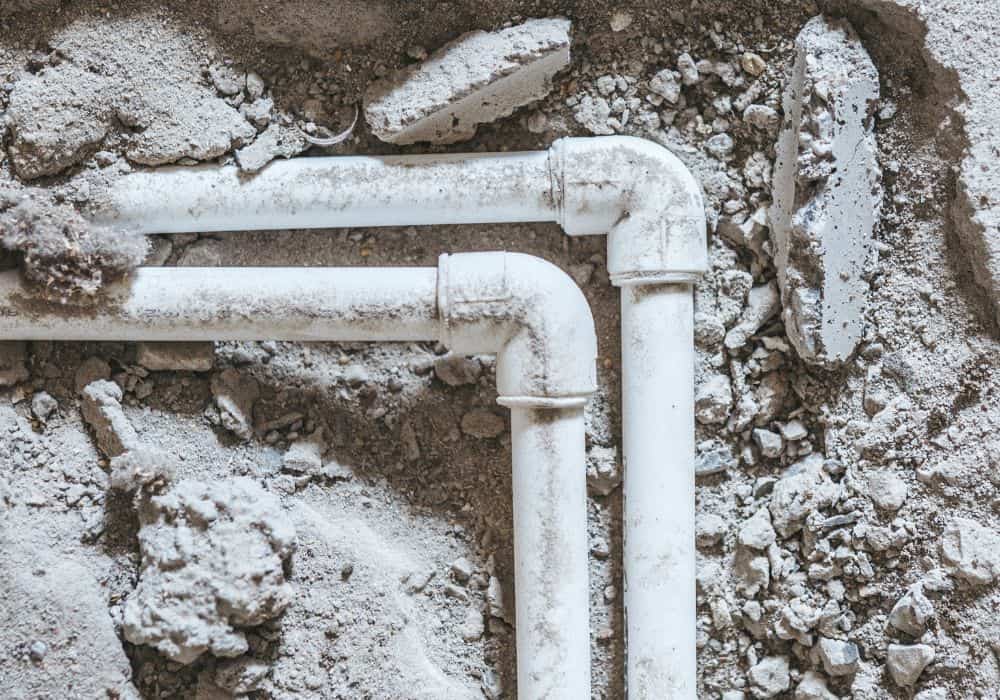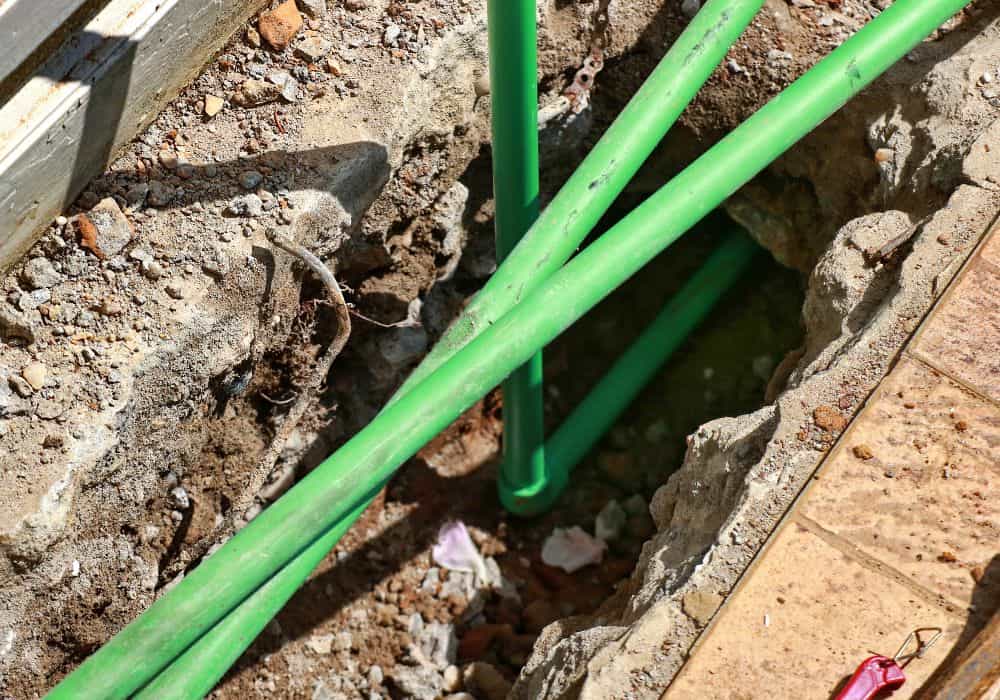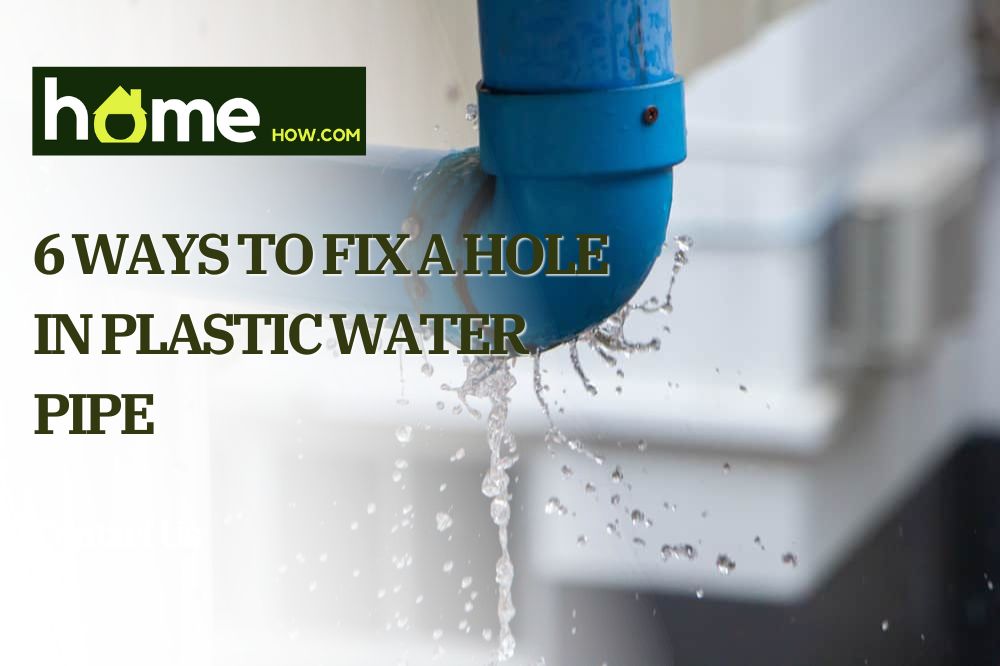Plastic pipes – also known as polyvinyl chloride/PVC pipes – are commonly used in plumbing, sewage, and irrigation. Although they’re durable and lightweight, they can be damaged and leak over time.
The good news is you don’t need to buy a replacement pipe right away. You can save a lot of money simply by following this guide on how to fix a hole in a plastic water pipe.
Tools Needed for Pipe Repair
There are many ways to fix damaged unpressurized pipes, as I’ll discuss below. Depending on the method you wish to try, you will need the following materials:
- Rubber tape and hose clamps
- Rubber and silicone tape
- Epoxy putty
- Fiberglass resin tape
- Fiberglass resin cloth and UV light
- Joiners, ratchet cutter, cobra clips or poly clips, and pliers
How to Patch a Leaking PVC Pipe

Plastic pipes work well, especially if they are glued together accordingly. But like most plastics, it’s not 100% safe from leakage.
As you see, pipe damage may occur because of the following reasons:
- Use of the ‘wrong’ type of PVC cement
- Incorrect pipe installation
- Puncture or impact on the pipe (for example, you accidentally hammered a nail onto it)
- Extreme cold
Should any of these cause a hole in an unpressurized plastic pipe, you could try any of these quick-fix measures:
1. Rubber Tape and Hose Clamp Method
These materials help compress the holes/leaks on the pipes, thus preventing them from leaking. As one of the easiest methods in this list, it only involves two easy steps:
- Wrap the rubber tape around the affected area.
- Place hose clamps over the holes/leaks. Make sure to tighten them.
Pro tip: This is just a temporary fix! Your rubber tape and hose clamp won’t be as effective if the leak has grown in size.
2. Rubber and Silicone Repair Tape Method
Using a rubber/silicone repair tape is another easy way to plug the small holes in your existing pipe. It can help seal the cracks simply by ‘bonding’ to itself.
One of the great things about this method is there’s no need for fancy tools. Not only does the tape stick to itself, but it can stretch to up to 300% more.
Rubber and silicone tape can also withstand pressures of up to 30 bar. This makes this material handy for sealing leaks in pipes where you can’t turn off the water source.
You don’t also have to worry about making a big mess when using this tape, compared to when you’re using a sticky adhesive material.
Here’s how to fix your pipes with the use of rubber and silicone tape:
- Wrap the tape around the hole tightly. Make sure to cover the areas around the leak as well.
- Let the tape do its magic. In a few seconds, it will immediately form tight water and an airtight seal around the hole.
3. Epoxy Method
Repair epoxy is a type of putty (viscous liquid) that seals cracks on the pipe and its joints. When applying this material, you need to:
- Clean and dry the affected area.
- Mix the epoxy putty according to the manufacturer’s directions. If you’re using a putty stick, all you need to do is cut the amount you’ll use for sealing.
- Apply the epoxy to the damaged area. Let it cure for at least 10 minutes.
- Turn on the water supply an hour after the putty is applied. That way, you can see if you have sealed all the leaks correctly.
Pro tip: Epoxy putty (especially the stick form) is best used in tight spaces, as all you need to do is slap it on the hole. You don’t have to wrap it around, as you would with a rubber and silicone tape.

4. Fiberglass Tape Method
A fiberglass tape is equipped with a water-activated resin that will harden around the pipe and seal the minor leak.
If you plan on using this material, you need to:
- Clean the damaged section of the pipe with a damp cloth.
- While the pipe is still wet, apply the tape around the small leaks.
- Leave the resin to harden for at least 15 minutes.
5. Fiberglass Resin Cloth Method
Fiberglass tape works, but it’s more of a temporary fix. So if you’re looking for a more permanent one, then go for a fiberglass resin cloth. It’s resistant to temperature change, which comes in handy since extreme cold can lead to burst pipes.
Here’s how to use a fiberglass cloth:
- Clean the leaky area with a damp cloth.
- Sand the affected area as this will help make the fiberglass wrap bond better to the leak.
- Wrap the cloth around the affected area.
- Cure the resin by shining a UV light directly onto the area.
Pro tip: If you don’t have a UV light, you can cure the resin cloth by exposing the patched pipe to sunlight.
6. Joiner Method
If the methods above fail to seal the hole in your PVC drain pipe, then you may want to consider doing the joiner method. This fix uses pipe connectors/fittings that ‘join’ the two undamaged ends of a pipe.
Here’s how to install joiners, according to the video of a professional plumber:
- Cut both sides of the damaged pipe.
- Slide a poly clip or cobra clip on one side of the pipe.
- Push the joiner into the end of a cut pipe.
- Push the other end of the connector to ‘join’ the cut pipes
- Move the cobra clip or poly clip over the area where the joiner meets the cut pipe. Secure them by hand or with pliers.
Pro tip: Don’t tighten the clip too much, for you may end up bending and breaking the pipe!
FAQs
How Do You Prevent Plastic Pipe Leaks?
Just because you repaired or replaced your PVC pipes doesn’t mean they won’t get leaky again. To prevent further or additional damage, you need to be proactive and do the following:
- Inspect the Pipes Regularly
It’s not enough to just look for signs of damage (i.e. pipe discoloration.) You will need to touch the pipes for it will help you detect moisture immediately.
While it’s important to inspect all the pipes around the house, you should pay further attention to pipes in these high-risk areas: kitchen sink, dishwasher, bathroom sink, and washing machine.
It will also help to assess the pipes for loose or weak connections. Don’t wait for them to break down! Tighten the fittings with pliers and repair what needs to be addressed before they get completely damaged.
- Insulate the Pipes
If you live in a cold area, then your plastic pipes are at a higher risk of damage. The water inside can freeze, and this ice buildup will end up applying undue pressure to the pipes.
The result: burst pipes.
So before the colder seasons hit, make sure to insulate your pipes right away. Here’s a video on how to do it yourself.
- Install Electric Water Sensors
Some of your PVC pipes may be located in a tight space. As such, you may not be able to inspect them as often as you want.
That being said, you may still prevent pipe leaks by installing electric water sensors in these areas. They will shut off your water source at the first sign of a leak/moisture buildup.
When Should You Replace a Damaged PVC Pipe?
Here are two scenarios that require you to replace the damaged area of the pipe:
- The leaky pipe is pressurized (the quick fixes above will just fail, no matter how hard you try)
- The damaged area is too extensive to be repaired with the aforementioned methods
While replacing PVC pipes (especially in a tight place) might seem tough, it is doable. First, you need to prepare the necessary materials:
- Hacksaw
- Replacement PVC pipe
- PVC primer
- Pipe glue/adhesive
Once you have all the equipment above, you can go about replacing the pipe. Here’s how to:
- Shut off the pipe’s water source. Drain the excess water in the pipes.
- Cut the damaged/leaky area.
- Cut a part from the replacement PVC pipe. Make sure to dry-fit it in the area it’ll occupy to see if it sits properly.
- Apply PVC primer on the parts that will be affixed together.
- Apply a liberal amount of adhesive on said parts.
- Attach the parts immediately because the adhesive will set in right away.
- Hold the parts together for 30 seconds or longer, depending on the time specified in the manufacturer’s instructions.
- Wipe off the excess adhesive material.
Conclusion
Plastic pipes may be damaged due to punctures, incorrect installation, the wrong type of PVC cement, and extreme cold. To fix such leaks, you can use any of the following:
- Rubber tape and hose clamps
- Rubber and silicone tape
- Epoxy putty
- Fiberglass tape
- Fiberglass resin cloth
- Joiners
It’s important to note that these fixes only apply to unpressurized plastic pipes or smaller leaks. For pressurized pipes or larger holes, you may need to replace the damaged section right away.
Do you have more questions about fixing holes in PVC pipes? Just post a comment and we’ll be more than happy to help.
